
In this issue, I have the pleasure of publishing an article by Wim van Utrecht, which describes a sighting of a UFO that appeared to block the path of an ambulance in Poland. Wim’s research indicates that the UFO was actually the setting moon.
It may come as a surprise to some that the moon can cause UFO reports. The quote from Hendry on the front cover demonstrates, that he was surprised when he had reports that turned out to be the moon. In one instance, he reports having police officers chasing the setting moon! The Blue Book files also contain quite a few reports that were the moon. Probably the biggest indicator that the moon was involved usually has to do with the described appearance and behavior of the UFO. Confirmation that it probably was the moon is given when the witnesses state they were looking in the general direction of the moon but only saw the UFO.
Two of the biggest contributing factors to the moon being reported as a UFO is the moon illusion and atmospheric conditions.
The moon illusion gives the observer the impression that the moon looks much larger when close to the horizon. Atmospheric conditions can make the moon appear distorted and reddish-orange. Both effects can confuse people into thinking they are seeing something other than the moon.
+++
Lunar Terror in Poland
A Doctor’s Dilemma
Wim van Utrecht
The subtitle of the present article is borrowed from a caption that accompanied a drawing on the cover of the March 1981 issue of Flying Saucer Review (Fig. 1). The drawing is an artist’s rendering of a UFO incident that is detailed in an article on pages 2-4 of the journal. Its author: the well-known Polish ufologist and sci-fi & fantasy writer Emma Popik1. Popik’s report describes a scary encounter between the occupants of an ambulance car and an unidentified object “hovering centimetres above a road” near a railway crossing in Northern Poland. We give you the highlights below, cited directly from Mrs Popik’s contribution to what was once considered to be the world’s leading UFO publication.
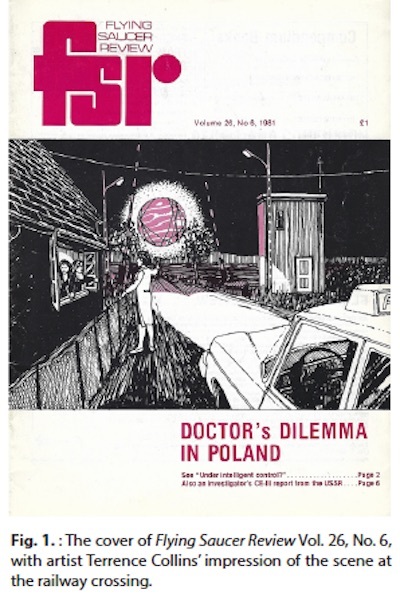
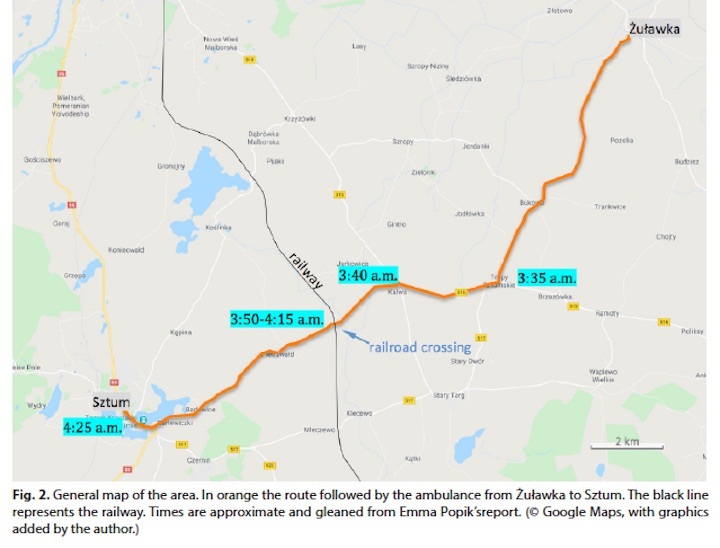
The encounter
“On September 5, 1980 at 3.15 a.m., the telephone rang in the first-aid department of the hospital at Sztum. An ambulance set off quickly in response to the call. Its destination, the village of Zulawka, where a confined woman, Mrs. Elzbieta Pluta, aged 25, was waiting. Aboard the ambulance were Dr. Barbara Piazza, Grzegorz Skoczynski the driver, and stretcher bearer Andrzei Olejuik. (...) At about 3.30 a.m. they were on their way back to [the] hospital. Elzbieta Pluta was comfortable, sitting, not lying —which means that there was still a little time. She had pains every ten minutes.
Suddenly Dr. Piazza noticed a big red ball in the sky, some distance from them. She asked: What would that be? (...) At that point the time was about 3.35 a.m., and the ambulance was near the village of Tropy. The red ball was well in view. Indeed, as they passed through Tropy, the object was as large as the moon to look at, dark crimson in colour, and coming closer all the time. The driver could also see it when he was able to take quick glances, and they all became very interested when the ball approached within a measurable distance —about 500 metres [1,640 feet]— and moved on an oblique course to the road, from N.E. to S.W. over gently sloping hills. It did not appear to be at any great height, the angle of elevation being between 15° and 20°.
Said Barbara Piazza a few days later: I was always aware that it was never exactly in the sky; it was not very high over the ground any of the time.
Soon the ball was at the level of the tree tops and at a distance of about 200 metres [656 feet] from the ambulance. All the passengers were watching it in silence.
At about 3.40 a.m. the moon had waned [set? —Ed. FSR] and the ball was swinging past the trees in gentle curves as they left the village of Kalwa behind them. By now the ball was about 150 metres [492 feet] to the left of the ambulance.
Wishing suddenly to escape from the object, the driver accelerated. Whether at 130 km/h or at 90 km/h, it was just as if the ball were linked to them by cord; it never changed its distance from them. Later, while I was interviewing the doctor, she said: It seemed obvious to me that that object was under intelligent control. We just could not lose it. It was pacing after us!
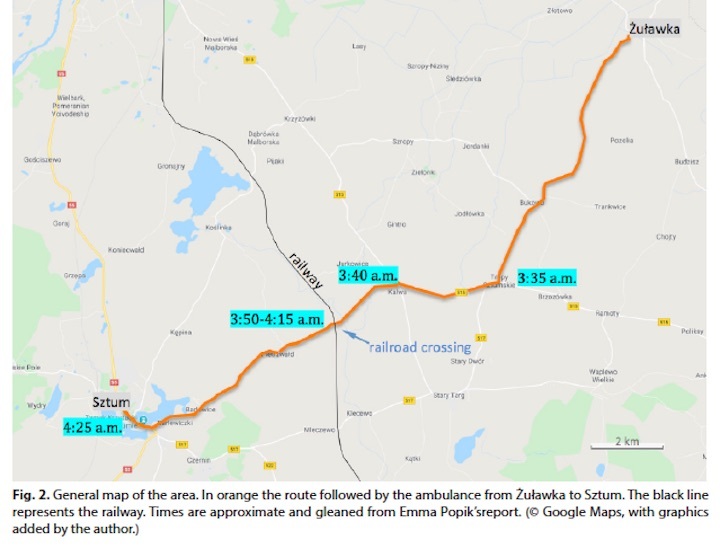
Soon the ambulance was approaching the railway level crossing between Kalwa and Sztum. The driver continued a few metres, but then stopped: the red ball had suddenly appeared about 200 metres, or less, ahead of them in the road. They hadn’t seen it dash ahead of them, but it stopped (…) between two trees. The carriageway is 6 metres wide at that point, but the edges of the UFO overlapped the road on either side, between the trees, by about 50 cm.
The surface of the UFO displayed curved bands and stripes, with a lot of black lines going up and down irregularly in each direction. One of the eyewitnesses compared these clear-cut markings with veins inside a human body, while another compared them to a net. Only the doctor couldn’t see the veins, for she is short-sighted, and wears spectacles. But she could see how parts of the surface changed colour. There appeared to be yellow-orange patches on its deep crimson surface, and all four of them could see that.
Dr. Piazza mentioned something about the possibility of radiation, and she instructed the driver to move the vehicle away behind the level crossing, and when that was done she examined her patient, whom she found to be not too bad, but with not a lot of time left.
I had seen the ball, said Mrs. Elzbieta Pluta when I spoke to her later, and I also noticed the ‘veins’, but I didn’t pay much attention to the thing. Let UFOs be UFOs, I thought; my problem was how not to bear my baby in an ambulance, for by then I was having pains every five minutes.
Dr. Piazza got out of the ambulance and approached the house where two crossing keepers were on duty. They were Józefa Kamińska and Gabriela Ludorf, and they were leaning out of the window.
Can you see what I can see? Asked the doctor.
We were looking at it for a while, one of them answered.
We can ask them for anything, interrupted the driver, Skoczynski, the girls are trembling with fear.
Turning back to the ambulance the doctor picked up the radiophone, and got in touch with the police. There’s an obstacle in our way, she reported. Come, please.
What obstacle?
A UFO. (…)
The object hovered a few centimetres over the road, all the while changing colours, getting brighter, then less bright, but always with a dull finish. Suddenly it moved slowly to the right and stopped behind the tree. Its yellowish light shone through the leaves; momentarily the tree was on fire. The object then moved up the slight hill, hovered at the summit, then returned after a few seconds. The watchers could see a strong white light underneath the ball, and the light stretched left and right. There seemed to be a flood of white light beyond the horizon, but, said the doctor, undoubtedly the horizon was behind the object. (…)
Minute by minute the doctor checked the time because of her patient. The situation was now urgent, and she called the police
station again.
Meanwhile the object was changing back to its original colour. The orange patches disappeared, and the whole thing became deep crimson.
The doctor looked at the patient and knew they could wait no longer. Her thoughts raced . . . surely it would know we have no time if we give it a signal? She turned to the driver: Flash the headlights, she said, and he did so, twice. Then, one second they could see the crimson UFO as they began to move forwards, the next second it vanished . . . like a TV set when switched off.
That was at about 4.15 a.m., and 10 minutes later the ambulance is in the hospital. At 6.10 a.m. Mrs. Elzbieta Pluta bore a daughter, Aneta, 2,600 grammes, her fourth child.”
So far the events as recounted by Emma Popik in her report for FSR. In addition, British researcher Martin Shough came across a 28 minutes-long audio file2 containing fragments of Emma Popik’s interview with ambulance driver Grzegorz Skoczyński, stretcherbearer Andrzej Olejnik and crossing keeper Gabriela Ludorf. A friend of the author translated the interview from Polish to Dutch. It tells us that, eventually, police officers did arrive at the level crossing. In fact, the driver found them talking to the crossing keepers when being sent out by the hospital for a second call later that morning3.
So what was this ball with “yellow-orange patches on its deep crimson surface”, pacing four people in an ambulance car as if it “were linked to them by cord” before blocking the road in front of them? To experienced investigators of weird sky phenomena, these descriptive elements immediately ring a bell: a reddish ball of light pacing a vehicle reminds strongly of the moon, sitting close to the horizon and seemingly copying the movements of the vehicle due to what is known as the parallax effect4. But can the moon fool six people to such an extent that an urgent ambulance ride is interrupted and police assistance sought? To answer that question we need to find out if there was a full or near-full moon in the right part of the sky that September morning.
The stop at the railway crossing
There’s one phase during the incident for which the line of sight to the unidentified object can be determined with precision, namely when the ambulance was stopped “a few metres” beyond the railway crossing, then drove approximately 200m (656 feet) backwards to a point just before the barrier. The report is precise as to the location where this happened: the level crossing between Kalwa and Sztum. Using Google Street View it was not too hard to find this location (see Fig. 3). Its geographical coordinates are 53°56’27”N and 19°07’18”E. Looking in the direction where the red ball was observed, namely hovering directly over the road in front of the witnesses, we found that the azimuth of the red ball would have been exactly 244° during that phase.
Next we checked if the moon was anywhere near that spot in the early hours of September 5, 1980. It wasn’t… When the witnesses were at the crossing (at about 4:00 CEST or 2:00 GMT), the moon would have been in the East (azimuth 85.5°; elevation 19.5°). In other words, the moon was nowhere near the Western horizon and too high in the sky for it to have appeared reddish in colour due to atmospheric scattering of the shorter wavelengths. Moreover, only 17% of the lunar disc was illuminated that morning, giving it the shape of a thin crescent, not a ball.
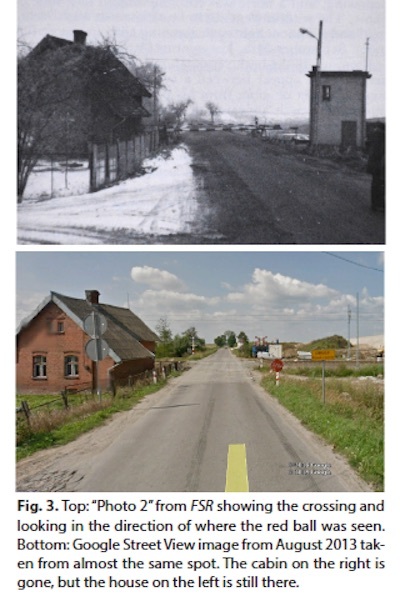
End of story? We must admit that these negative findings came somewhat as a surprise. After all, everything in Emma Popik’s report pointed to the moon as the obvious culprit. So we decided to enter a few other dates in our sky map program. Perhaps there was a moment not too far away in time when the moon was in the right position. We struck gold when typing “1979” instead of “1980.” Indeed, if the incident were to have occurred exactly one year earlier the match would be perfect! That day, September 5, 1979, at 4:00 a.m. the moon was 97% illuminated and sitting close to the horizon at azimuth 245°.
Could it be that Popik got the year wrong? That seemed very unlikely, because Popik stated she had interviewed the witnesses two days after the event. More plausible, perhaps, was that she hadn’t mentioned the year in her report, and that it was the late Gordon Creighton, then acting editor of FSR, who added “1980,” thinking the event would most likely have occurred not too long before he had received the report. In a first attempt to find out if the year could be in error, we checked the internet hoping to find the date of birth for Mrs Aneta PLUTA, the daughter to whom witness Elżbieta Pluta was about to give birth less than three hours after the sighting. That would tell us in which year the incident occurred. Alas, the search proved fruitless.
We then started looking for Polish references to the case by typing terms like “Sztum,” “UFO,” “5 września 1979,” and “5 września 1980” in Google Search (“września” being Polish for “September”). That quickly took us to an online article at a website called UFO Relacje. Its title: “UFO nad miejscowością Tropy Sztumskie 5 września 1979.” In English: “UFO over the village of Tropy Sztumskie on September 5, 1979.”5 The account we found there clearly concerned the incident we were interested in. An added footnote further reassured us that the summary was based on “press articles from 1979.” And if that weren’t enough, the link that directed us to the interview also mentioned: “obserwacji czerwonego świetlistego obiektu UFO - Sztum 5 września 1979 (observation of a red luminous object – Sztum September 5, 1979). So there we have it: the Tropy Sztumskie encounter occurred not in 1980, but in 1979!
Besides a case summary, the UFO Relacje article also featured this photographic rendering:
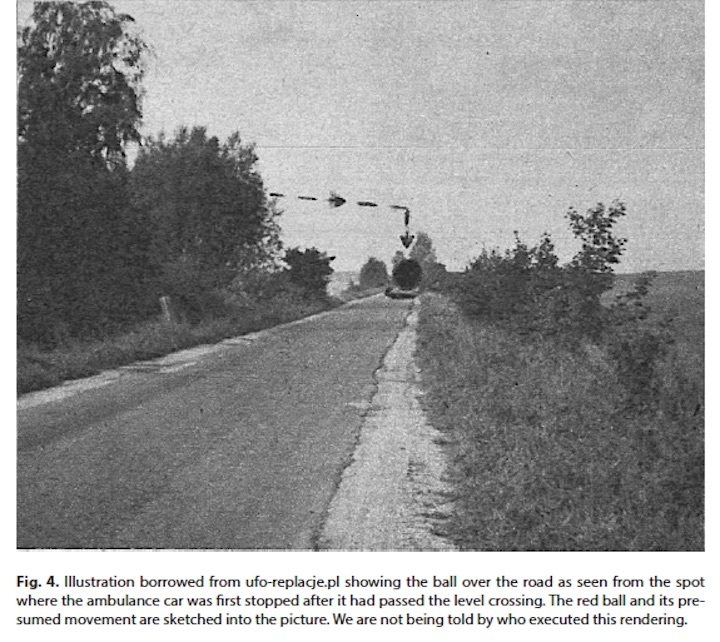
Now that the exact date and time were established, it was time to check the moon position again. The sky map in Fig. 5 shows how the night sky would have appeared to someone standing at the crossing and looking towards the WSW on September 5, 1979, at 4:00 a.m. Some five minutes earlier, from that spot, the moon would have been seen exactly in the middle of the road, at azimuth 244°. It suggests that the party arrived at the crossing at 3.55 a.m., which is in perfect agreement with the reported chronology of events.
97% of the lunar disc was illuminated, with full moon occurring on the 6th. The natural displacement of the moon would have made it move slowly from the left side of the road to the right, which is consistent with Dr Piazza’s statement that “it moved slowly to the right.” According to the driver, the ball was lost from sight when it “began to shrink and disappeared without a trace in 2-3 seconds” (UFO Relacje). It was then “about 4.15 a.m.” (FSR), or in the taped interview: “it remained there till ten past four or a quarter past four”, which again can be considered a perfect match for the time of the setting moon, namely 4:13 a.m. (and not “at about 3:40 a.m.,” as Popik stated6). The moon was then at azimuth 248°.
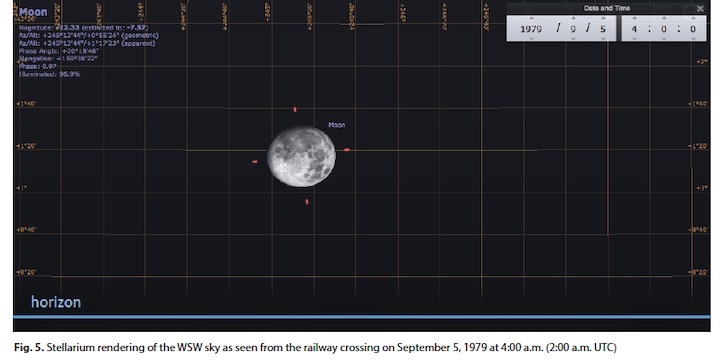
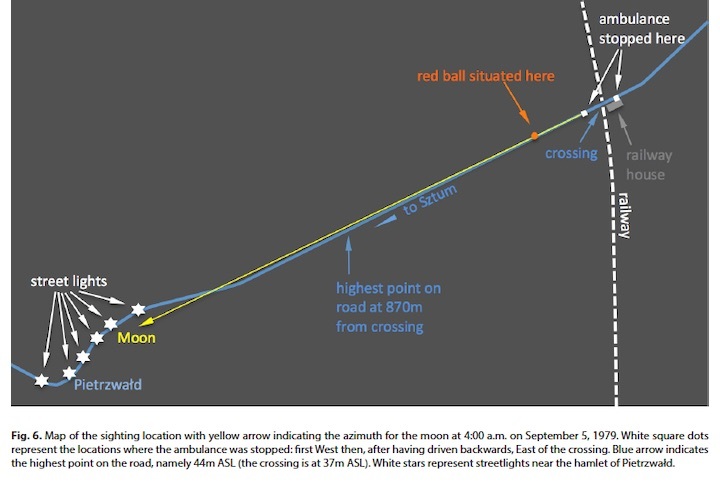
But six witnesses watching the moon for about half an hour and not recognizing it for what it is. Is that possible? Well, that representation of the facts is not entirely correct. When interviewed by Mrs Popik at the railway house two days after the incident, crossing keeper Gabriela Ludorf stated as follows:
“We had been looking at the ball for a while. Over the hill that you can see over there [we assume that at this moment during the interview the witness is pointing towards the hill in question]. We had already raised the barriers before the ambulance arrived because a motorbike wanted to cross over. We closed the barrier again and after that we saw the ambulance. I told my colleague to raise it again. The ambulance crossed the barrier, then quickly reversed to park itself just in front of the railroad. Oh my, perhaps they want to ask something. Something may have happened! So the barrier went up again. I told my colleague Józia [short for Józefa] “What is that ball?” Józia said: “That’s the moon” [laughter]. Then someone [Dr Piazza] came out of the ambulance and asked if we saw that ball too. She then started talking about possible radiation. That’s when my hairs stood up. We had been looking at the ball for some time before the ambulance arrived, but hadn’t given it much thought because we figured it was the moon. I don’t know exactly when the ball had appeared, but when I saw it, it was over a small hill in the field about 2m above a pole. Dark red and bigger when compared to the moon. Not twice as big but about one and a half times the moon.”
In summary: it seems that the anxiety among the two girls was largely due to the arrival of the ambulance car, it driving backwards over the rail, the doctor stepping out, approaching them and starting to ask questions about the ball while hinting at possible radiation. Not a folie à deux, but a folie à trois so to speak. But Gabriela’s account also raises another question: how could the two crossing keepers have been looking at the red ball “for some time before the ambulance arrived” if that same ball was believed to have chased the ambulance over a distance of 5.3km from the village of Tropy to the level crossing?!
The chase
Popik gives no precise indications about the direction in which the object was seen for the episode it was witnessed from the driving ambulance, only that “as they left the village of Kalwa behind them (…) the ball was about 150 metres to the left.” The UFO Relacje web article confirms this: “At 03:45 the ambulance was approaching the Sztum Trail, and when it reached the intersection, driver G.S. noticed, on the left, a dark red matte ball.” The vehicle was then on Route 515 approaching the turn off onto the “Sztum Trail”, which involves negotiating two consecutive junctions or “intersections” (Fig. 7). It is when the vehicle is approaching the first junction that the red ball is first seen “on the left.” The witnesses were then heading NW (Fig. 8). This is found to be in accordance with the position of the moon at that moment (3:40 a.m., according to FSR), namely SW (azimuth 241°).
The next actions are accelerations and decelerations by the ambulance, matched by the “pacing” object. Plausibly this is when they were turning south between the two nearby junctions at Kalwa, and when the object was “swinging past the trees in gentle curves” (FSR). This would have been the moon “pacing” them (FSR) on their left as they initially headed towards the junctions near Kalwa, then after “swinging” about during the turns, it would have “dashed ahead” and remained roughly ahead or slightly to the right as they headed SW towards the crossing. UFO Relacje: “when they passed Kalwa, the ball suddenly accelerated and overtook the ambulance to hang over the road.” Just before the crossing, the road takes a weak turn to the right. As a result of this, the moon would have appeared to ‘swing’ right in front of them before it stopped. That all generally fits the map and the likely relative motions of the moon.
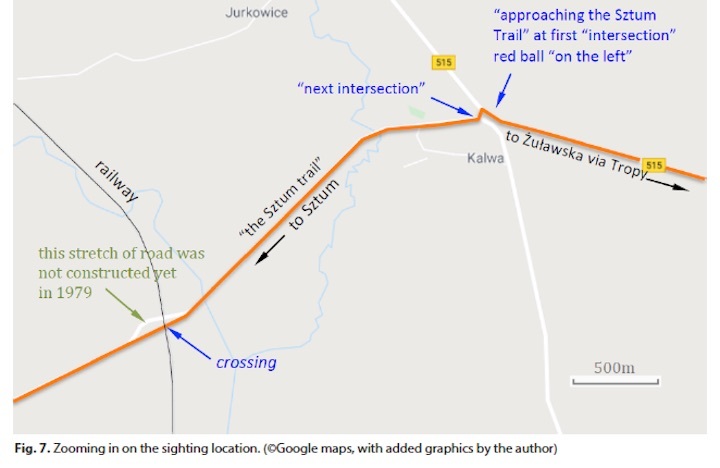
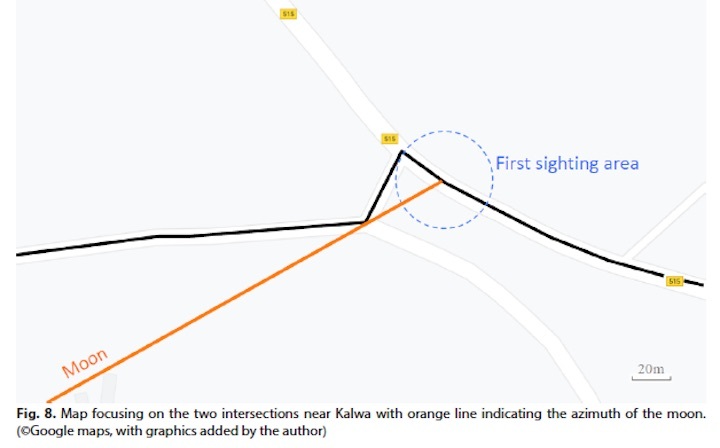
Shape, colours and size
We already pointed out that there was a near-full moon on the night of the encounter with 97% of the lunar disc illuminated. That phase of the moon is consistent with the description of a luminous, ball-shaped object. Telling in this regard is that, when during the interview Popik asks the driver to draw the object, Skoczyński replies: “Not sure how to do that”, upon which the stretcher bearer tells him: “Just draw the moon, that’s as close as you can get.”
Tree branches in front of the lunar disc would have created the effect of “a lot of black lines going up and down irregularly in each direction” (see Fig. 8). Popik’s article states: “Its yellowish light shone through the leaves” (our emphasis), while in the interview the driver stipulates that the luminous ball “had no influence on the trees”. Both statements suggest that the object was not in front of but behind the trees that can be seen behind the end of the road in Figs 3, 4 and 11. Semi transparent clouds, together with the typical darker and lighter areas on the lunar surface, can further account for the “yellow-orange patches”, the overall red colour being due to the big amount of atmosphere between the observer and the low moon (and hence more scattering of blue light).
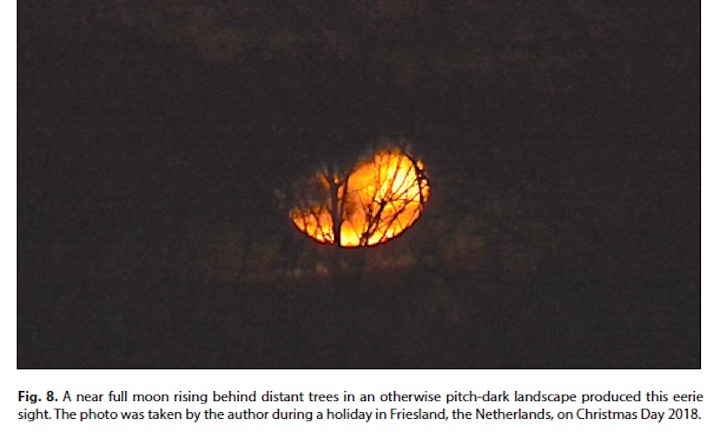
But there’s a problem. According to Popik, when the ambulance was approaching the double junction at Kalwa, the witnesses situated the object at an angle of elevation “between 15° and 20°.” From the recorded interview it transpires that in order to estimate the elevation, Popik had asked driver Skoczyński to imagine a line leading from the eyes to the object then estimate the angle that line made with the horizon. Using this method, an angle of 35° was retained for the moment the car was at the intersection of Route 515 and the Sztum Trail. It is not clear why that angle is almost twice as big as the angle mentioned in FSR. The ambulance arrived at the intersection between 3:35 and 3:40 a.m. At that time the moon’s was only between 3°37’ and 4°12’ above the horizon, not 15 or 20°, let alone 35°. Moreover, at angles larger than 10° the amount of atmosphere between observer and moon is not dense enough to create a striking reddish tinge.
The question is to know how reliable the figures given by Popik are. Experienced investigators know that estimates of elevations are almost always off, and not by just a few degrees. In fact, an (unpublished) study carried out by the author on 132 Belgian cases in which reported UFOs could be attributed to astronomical bodies, confirmed rather spectacularly that the elevation of an object in the sky is almost always grotesquely overestimated. In 29 cases we studied, the witnesses had estimated that the elevation of the object they had sighted was between 15° and 25°. In 3 of these, the reported phenomenon could be attributed to a celestial object only 3° above the horizon. In 9 out of 29 cases, the mistaken celestial bodies were found to have been at altitudes between 4° and 8°. In 46 cases the elevation angle was estimated to have been between 25° and 40°. 18 of these (i.e. 39.1%) were triggered by an astronomical source lower than or equal to 10° (7 of these with elevations lower or equal to 5°).
In fact, an angle of 15 to 20°, as mentioned in Popik’s report, is perceived as quite high in the sky, and would never be described as “never exactly in the sky” or “not very high over the ground any of the time” (FSR). Parts of the landscape bordering the road between Tropy and Kalwa offer wide views over low hills and fields (Fig. 9). In these circumstances, situating an object “at the level of the tree tops” (FSR) and “passing trees and farms” (taped interview) would also suggest that the objects were close to the horizon.
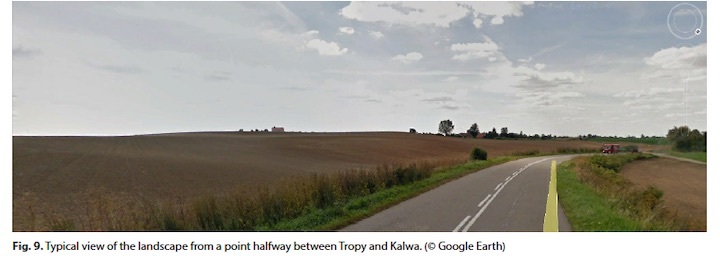
Confirmation of the low altitude of the sighted red ball during the first phase of the event came when our long-time Spanish correspondent Manuel Borraz Aymerich called our attention to an article written by Stanislaw Barski and published on a Polish blog called Paranormal.PL.7 We had missed that source when we set out to reexamine the case. Yet, it contains an interesting quote. Barski doesn’t mention his source, but he cites driver Skoczyński as follows: “It was 3.45. I just turned from Żuławka Sztumska to the Malbork road [Route 515]. That’s when we noticed a dark red ball far ahead the size of the moon floating in the sky quite low above the horizon.” This conclusively confirms our initial suspicion: the phenomenon was never observed at an altitude between 15 and 20°, let alone 35°.
The elevation is not in dispute when it comes to the final and longest phase of the incident. By this time, the object had descended to “a few centimetres over the road” (FSR), or, according to the driver’s account in Barski’s article: “to a height of about 1m, 1.5m at most,” or still according to UFO Replacje: “to a height of about 2 m.” Any which way, it is clear that the object was very low in the sky during this phase.
There are several bizarre details in the descriptions given during the interviews Popik conducted. One relates to the driver clearly seeing —besides the “grid of black irregular lines”— “two dark horizontal stripes” or “shelves,” “bottom and top.” According to the UFO Replacje article these “shelves” were “visible only when the ball hung over the road.” Thick mother branches or stacked clouds near the horizon (the latter illustrated in Fig. 10) might account for these two dark stripes. More difficult to explain is Mrs Pluta’s claim that she also noticed “something like an antenna” on top of the ball, making it look “like an inflated balloon on a wire” (Barski). Oddly, none of the other witnesses reported this detail. Could this have been a streetlight reflecting off of a telephone wire near Pietrzwałd?
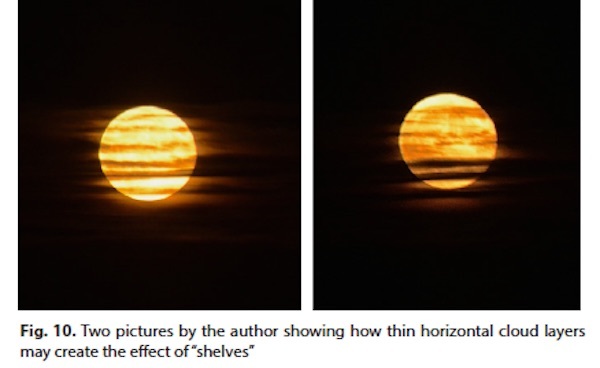
With regard to the size of the ball, the witnesses are unanimous: “the object was as large as the moon to look at (…) and coming closer all the time” (FSR). In Barski’s article there’s an interesting quote from Dr Piazza who, we are told, tape-recorded her story after returning home that morning. The quote refers to the moment when the phenomenon was first seen. It goes as follows: “On the way back, a few kilometres after Żuławka, a red cloud appeared on the driver’s side over the horizon. It was strange; it looked like the setting sun. I joked to the driver: ‘Tell me what it could be: sun or moon? Surely it can’t be a UFO.’ The driver said it was the moon!” It is only a few minutes later that the moon explanation is abandoned because the object “became bigger, orange-red and clearly outlined.”
It is important to note here that most people are convinced that the moon increases in size as it nears the horizon8. Likewise, witnesses who mistook the setting or rising moon for an unidentified craft typically estimate the size of the UFO as bigger than the moon. Gabriela Ludorf described the object’s apparent size as “not twice as big, but about one and a half times the moon,” which is precisely how other mistaken witnesses have described the setting or rising moon9.
In the Tropy-Sztumskie case we have precise numbers to work with. When at the crossing, the size of the ball was compared to the width of the carriageway, which Popik asserts was “6 metres [26 feet] wide at that point”. “At that point” refers to the spot on the road where the witnesses believed the ball was, namely “200 metres [656 feet] or less” from the ambulance car after it had crossed the railway. Popik also informs: “the edges of the UFO overlapped the road on either side (…) by about 50 cm [1.6 feet].” At 200m, a 6-metre wide road has an angular width of 1.7°. With the moon diameter covering only about 0.5° of the sky, that would mean the moon took up only about 1/3 of the road. But, like with elevations, estimates of distances at night cannot be trusted. Interestingly, the road behind the barriers goes upward from the crossing (angle of inclination approximately 0.5°), then down again towards the hamlet of Pietrzwałd. According to Google Earth, the highest point on the road is at a distance of 870m from the level crossing (see Fig. 5). Having driven past the railway for “several meters” (FSR), we can round that down to 800m (2,625 feet). Beyond that point the road goes downhill again and is no longer visible from a point near the crossing (see Fig. 11).
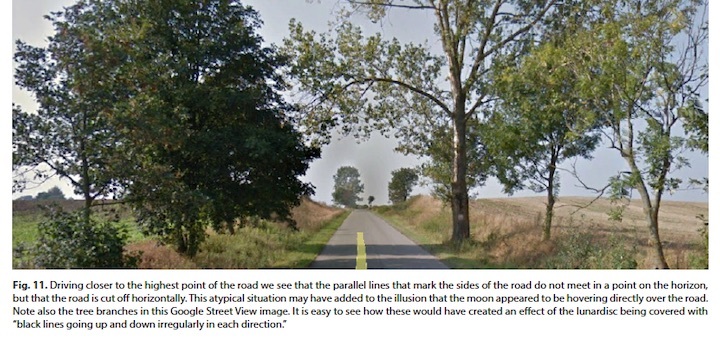
If the moon was mistaken for an object hovering over the road, it would logically have been this visible ‘end’ of the road that was believed to be directly underneath the object. Now, at 800m, a 6m-wide road would subtend a horizontal angle of 0.43°. In other words, to someone standing near the crossing, the moon being 0.50° in diameter would indeed have appeared somewhat bigger than the width of the carriageway.
Reported movements
During the interview with Popik, one of the crossing keepers mentioned that the object they presumed to be the moon was “rocking up and down”. The driver further stipulates that it “lowered step by step,” whilst the doctor asserts that after she returned to the car “the ball was still hovering”, but that after 15 minutes “it glided over the tree and continued to hover slightly” (Barski). Popik herself writes in her report that the ball “moved up the slight hill, hovered at the summit, then returned after a few seconds,” whilst the sketched path in Fig. 4 shows a downward movement followed by a steep vertical chute.
If reported accurately, these motions are difficult to reconcile with the moon’s steady downward movement to the right. It is remarkable, however, that each witness seems to be describing a different type of motion. This makes us wonder if the reported movements cannot be attributed to movements executed by the witnesses themselves. Walking up or down a small step, driving up or down a hill, or taking a few steps to the left or to the right or to the front or the back, all these displacements could have caused the moon to shift positions with regard to fixed objects like a pole, a tree or a hill. With the witnesses believing that the object was never more than 500m away —while it was actually hundreds of thousands of km away— every change of position of the lunar disc in the visual field coupled to their own movements, would have been different from their expectations.
The white light
Popik also mentions that there was a “white light underneath the ball,” stretching “left and right” and a “flood of white light beyond the horizon.” In the interview, it is specified that the lights (plural!) shone downward and resembled the white lights of a car. The article from UFO Relacje has the white light “illuminating the ground beneath it.” With varying descriptions, it is difficult to imagine what exactly was observed during this phase. Using Google Street View we noticed that there are several old-model streetlights near Pietrzwałd, about 1.5 km from the crossing (see Fig. 5). We cannot be sure if these street lights were already there in 1979, but it is not far-fetched to suggest that the glare of lamp posts near this small village may have just reached out above the highest point of the road and in that way added to the strangeness of the scene. Another possibility is that the lights were effectively coming from a vehicle. Perhaps the motorbike that had crossed the railway a bit earlier was still driving around in the area.
Conclusion
Despite these and other minor uncertainties, the moon explanation appears solid. Apparently, Popik did verify if the moon was visible in the early hours of September 5 (possibly because not only the driver, but also the crossing keepers and the stretcher bearer initially believed they were looking at the moon), but she seems to be keen to get it out of the way as soon as possible by stating (erroneously) that “the moon had waned” (sic) at 3:40 a.m. Nothing could be further from the truth: even at 4:10 a.m., half an hour later, the near full moon was still visible and positioned exactly were the UFO was situated. In fact, moon set was at 4:13, the exact time that the mysterious red ball disappeared, namely between 4:10 and 4:15. Yet, none of the witnesses mentioned seeing the moon in close proximity to the red ball.
We consider the Tropy Sztumskie UFO incident, as it is referred to in Poland, as one of the finest examples of a moon/IFO report. It’s not unique, though. Already in the 1980s, French UFO skeptics documented dozens of similar cases in which the moon turned out to be the cause of —often spectacular— UFO encounters10. More recently, U.S. researcher Herb Taylor and the author collected many more such reports11, notably from the Low Countries and from the U.S. Air Force Blue Book files. We hope to publish more about this research in a not-too-distant future.
Postscript
The author found out a little late that he was not the first to attribute this scary UFO encounter to a misinterpretation of the setting moon. Already in 2011, upon information provided by Manuel Borraz Aymerich, Juan Carlos Victorio published a short article on the Tropy-Sztumskie case on his excellent blog Misterios del Aire12. It is good to find that the conclusions of that article are in perfect agreement with our own.
Acknowledgements
We are grateful to Martin Shough for proofreading this article and for helping us map the location and line of sight for the early phase of the sighting. We are further indebted to Manuel Borraz Aymerich for directing us to Stanislaw Barski’s article, and to Herb Taylor for initiating the reopening of this cold case from the UFO archives. A final word of thanks goes to Monika Zielinska for a verbal translation of Emma Popik’s taped interview from 1979, and to Mieke Tiebos for her help in conducting the study on estimated vs real elevation angles in Belgian UFO reports.
© CAELESTIA, January 2020
Quelle: SUNlite 2/2020

